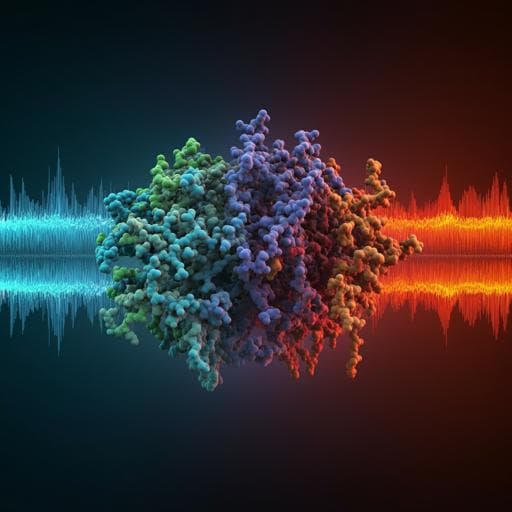
Biology
Mapping protein dynamics at high spatial resolution with temperature-jump X-ray crystallography
A. M. Wolff, E. Nango, et al.
Explore the innovative fusion of a solvent-based temperature jump with time-resolved crystallography to witness atomic vibrations in lysozyme, revealing how inhibitor binding influences enzyme dynamics. This exciting research was conducted by a team of expert authors.
~3 min • Beginner • English
Introduction
Protein conformational dynamics underlie ubiquitous biological functions, including enzyme catalysis, signal transduction, and allosteric regulation, yet capturing these motions at atomic resolution remains challenging because crystallography and cryo-EM measurements are ensemble-averaged over space and time. This averaging obscures spatiotemporal coupling between conformers and hides transiently populated intermediate states. Integrative approaches combining high-resolution structures with spectroscopy can provide kinetics, but correlating spectroscopic observables to specific structural features is difficult. Time-resolved X-ray crystallography (TRX) overcomes these issues by perturbing a system and capturing a sequence of structural snapshots as it relaxes to equilibrium, enabling observation of kinetic couplings and transient states. While TRX has traditionally focused on photoactive systems or specialized perturbations, a general perturbation that excites a protein’s intrinsic dynamics is still needed. Because protein dynamics are universally coupled to thermal fluctuations of solvent, temperature-jump (T-jump) offers a broadly applicable route. Prior multi-temperature crystallography shows temperature tunes conformational ensembles at equilibrium, and IR laser-induced T-jumps have long been used in solution to probe folding and enzyme dynamics by rapidly heating water and transferring heat to proteins on timescales faster than most functional motions. Here, the authors implement T-jump TRX using serial femtosecond crystallography to directly perturb and visualize intrinsic dynamics of lysozyme, aiming to map how nanosecond thermal excitation dissipates into coordinated, functionally relevant motions across microsecond timescales and to test how inhibitor binding modulates these dynamics.
Literature Review
TRX has been pioneered in photoactive proteins and expanded with XFELs, bright synchrotrons, and serial crystallography, alongside methods such as photocaged ligands, mix-and-inject, and electric-field perturbations. However, most perturbations are system-specific, limiting generality. The coupling between protein motions and solvent thermal fluctuations motivates temperature as a universal perturbation; multi-temperature crystallography has mapped conformational landscapes and allosteric networks at equilibrium (for example in PTP1B), suggesting feasibility for time-resolved T-jumps. IR T-jump spectroscopy has probed protein folding and enzyme dynamics by exciting water O–H stretch, enabling rapid, uniform heating. Prior T-jump has been coupled to solution SAXS/WAXS to capture protein structural dynamics and quaternary transitions, and IR pulses have been applied to protein crystals to study denaturation, but rigorous time-resolved tracking of heating-induced motions in crystallo has been limited. For lysozyme, extensive literature documents hinge-bending domain closure and dynamic behavior using computational normal modes, NMR, FRET, and single-molecule methods, with transitions on tens to hundreds of microseconds. This context frames the present work applying T-jump TRX to a well-characterized, dynamic enzyme.
Methodology
Experimental design and sample preparation: Hen egg-white lysozyme microcrystals (≈10 µm) were grown by batch crystallization in sodium acetate buffer (pH 3.0) with NaCl and PEG6000; for inhibitor-bound experiments, N,N'-diacetylchitobiose (10 mg/ml) was included. Crystals were embedded in an 18% hydroxyethyl cellulose carrier and extruded via a high-viscosity microfluidic injector (75 µm nozzle, ~3200 psi) forming a stable free-flowing jet (linear velocity 9.43 mm/s; 2.5 µl/min), with helium sheath gas.
Pump–probe SFX data collection: Experiments were performed at SACLA BL2 (DAPHNIS). The sample was pumped with a mid-IR laser tuned to 1443 nm (7 ns pulse, ~540 µJ, ~50 µm FWHM spot), exciting water O–H stretch to induce a T-jump. Probe pulses were 9.5–10 keV XFEL pulses (~10 fs, ~1×10^11 photons) at 30 Hz, recorded on a custom 4M mpCCD detector. The IR laser operated at 10 Hz; acquisition interleaved light (pump–probe) images with two dark images (IR shutter closed), providing internal controls: per time delay, datasets comprised F_t (light), F_dark1, and F_dark2. Additional laser-off datasets without interleaving were collected. Time delays sampled were 20 ns, 20 µs, and 200 µs for apo; and 20 ns and 200 µs for chitobiose-bound. The minimum delay was limited by the 7 ns IR pulse duration. An IR camera and photodiode verified pump alignment and firing. The X-ray focus (~1.5 µm) was centered within the larger jet and IR footprint (~50 µm); the IR incidence was ~45° relative to the XFEL.
Hit finding and Bragg processing: Online feedback used a SACLA pipeline to identify hits and integrate/merge data. Offline, hits were processed with CCTBX/DIALS (dials.stills_process) for indexing and integration with refined detector/crystal models; merged and post-refined with cxi.merge, including error modeling (Ev11). Seventeen merged datasets were produced (apo: laser-off plus three delays with light, dark1, dark2; chitobiose-bound: laser-off plus two delays with light, dark1, dark2). Final structures against raw F values (laser-off, experiment, control) were refined in PHENIX with model building in Coot; molecular replacement used PDB 1IEE; models and reflections deposited (PDB: 8CVU, 8CVV, 8CVW, 8CW0, 8CW1, 8CW3, 8CW5, 8CW6, 8CW7, 8CW8, 8CWB, 8CWC, 8CWD, 8CWE, 8CWF, 8CWG, 8CWH).
T-jump estimation and detection: A simplified pure-water model estimated a maximum T-jump of ~21 K from the IR pulse (Beer's law/absorption at 1443 nm, energy deposition, volume, and heat capacity). Experimentally, T-jump was detected by analyzing isotropic diffuse solvent scattering. Radial averages of diffraction images were computed with median filtering to suppress Bragg peaks, scaled, assembled into a matrix, and subjected to SVD. The second right singular vector (v1) captured laser-dependent changes; corresponding left singular vector coefficients (u1) strongly correlated with IR on/off status. Additional validation included thermal expansion of the unit cell in light datasets versus dark controls.
Difference map analysis and quantification: Weighted difference electron density maps were calculated as w(F_t – F_dark2) phased by dark-state models refined against F_dark1, with per-reflection weights to improve difference amplitude estimation. Matched control maps used (F_dark1 – F_dark2). Spatial quantification used IADDAT, integrating absolute difference density above a threshold (|ρ| ≥ 0.04 e/Å^3) within 2.5 Å of non-water atoms, averaged per residue and mapped to Cα positions. Pairwise real-space correlation coefficients (RSCCs) between maps assessed common signals across delays and controls. A simulated map modeling a uniform 20% increase in B-factors (from the laser-off model) was generated to compare with experimental 20 ns maps.
Modeling high-energy conformations and ESFMs: Guided by difference maps, explicit alternate conformations were modeled for selected regions (e.g., Tyr23 side chain; loop 97–100 near the active site) and refined against extrapolated structure factor magnitudes (ESFMs): F_ESFM = N × w(F_t – F_dark2) + F_dark2, with N ranging 1–20. Coordinate, B-factor, and occupancy refinements assessed stability of high-energy states and occupancy trends versus N. Normal mode analysis (ANM via ProDy) of the ground-state apo structure provided theoretical motion vectors for comparison (combined top 20 modes, projected to visualize correlated motions).
Inhibitor-bound experiments: Parallel T-jump TRX was performed on chitobiose-bound lysozyme crystals (P4_3 2_1 2), collecting 20 ns and 200 µs datasets with interleaved controls. Structural comparison (apo vs holo) included ligand omit maps confirming chitobiose binding and difference map/IADDAT/RSCC analyses to assess how inhibitor binding alters the T-jump-induced dynamics.
Data and code: Raw data available at CXIDB ID205; analysis code (Python 3; numpy, scipy, pandas, matplotlib, seaborn, gemmi, prody, reciprocalspaceship) and ESFM-refined models/maps are on GitHub and Zenodo.
Key Findings
• Universal T-jump perturbation in crystallo: A mid-IR (1443 nm), 7 ns pump induces a rapid T-jump in lysozyme microcrystals embedded in a viscous jet, probed by XFEL SFX across 20 ns, 20 µs, and 200 µs delays (apo), and 20 ns and 200 µs (chitobiose-bound). A simplified calculation estimates a ~21 K maximal T-jump.
• Direct detection of T-jump: SVD of isotropic solvent scattering identified a laser-dependent singular component (v1), with left singular vector coefficients segregating clearly by pump status, confirming successful heating on a per-image basis.
• Crystallographic signatures of heating: Light datasets showed statistically significant unit-cell thermal expansion relative to interleaved dark controls (<1% axial increases; e.g., apo a=b expanded from ~79.45 Å to ~79.52 Å at 20 ns), and refined models exhibited increased average B-factors upon T-jump. Interleaved dark datasets matched the separate laser-off dataset, attributing changes to pump heating.
• Nanosecond-scale response: Weighted difference maps at 20 ns displayed widespread negative peaks centered on atomic positions surrounded by positive halos, consistent with increased harmonic motion (B-factor rise). A simulated map from a uniform 20% B-factor increase strongly correlated with the experimental 20 ns map (RSCC ~0.67), and still showed weaker correlation with later timepoints (RSCC ~0.33–0.37).
• Microsecond-scale evolution: At 20–200 µs, difference density localized into coupled positive/negative features adjacent to the protein, indicative of coordinated backbone and side-chain shifts. IADDAT analysis showed non-uniform spatial responses across residues, with the 20 ns signal strongest overall and the 20 µs map weakest, suggesting transient state dispersion. Loop 97–100 near the active site exhibited clear coordinated displacement by 200 µs, consistent with ANM-predicted motions.
• Explicit modeling of high-energy states: Multi-conformer models including alternative conformations (e.g., Tyr23 rotamer; loop 97–100 shift) refined against ESFMs remained stable and showed increased occupancy with larger extrapolation factor N (1–20), supporting low-occupancy population of high-energy states following T-jump. Major dark-state conformations were largely unperturbed.
• Inhibitor-bound modulation: Chitobiose-bound crystals showed similar 20 ns difference density to apo (vibrational response), but minimal evolution by 200 µs compared to apo. Quantitatively, ΔIADDAT between 20 ns and 200 µs was much smaller in the inhibitor-bound state, and RSCCs indicated high similarity among apo 20 ns, chitobiose 20 ns, and chitobiose 200 µs maps, but weaker correlation with apo 200 µs. Inhibitor-bound models retained higher B-factors at 200 µs than apo, indicating persistent short-amplitude motions without conversion into larger coordinated movements.
• Dataset scope and quality: Apo datasets included laser-off (n=9,464 images), 20 ns (light n=15,253; dark1 n=14,383; dark2 n=14,454), 20 µs (light n=13,681; dark1 n=13,559; dark2 n=13,893), 200 µs (light n=11,931; dark1 n=11,857; dark2 n=11,950). High completeness (~100%), high multiplicity, and robust CC1/2 supported data quality.
Discussion
This work demonstrates that IR-induced T-jump is a broadly applicable perturbation for time-resolved crystallography, enabling direct visualization of intrinsic protein dynamics at atomic resolution without requiring photoactivity or specialized ligands. The nanosecond response shows a global increase in harmonic motions (B-factors), while microsecond evolution reveals spatially localized, coordinated displacements linked to lysozyme’s functional motions near the active site, including loop 97–100 consistent with hinge-bending behavior. The intermediate 20 µs timepoint displays minimal distinctive difference density, consistent with a heterogeneous mixture of transient high-energy states that narrow by hundreds of microseconds as the system approaches a new thermal equilibrium. The inhibitor-bound experiments provide a functional control: chitobiose stabilizes a closed active-site conformation and limits larger-scale motions, preserving vibrational signatures at 20 ns but suppressing their dissipation into microsecond correlated movements, likely shifting these to longer times beyond the observation window. These observations align with independent kinetic and single-molecule studies on lysozymes that report transitions on tens to hundreds of microseconds and multiple pathways. Together, the results indicate that T-jump can excite a population of higher-energy conformations whose evolution reflects functionally relevant dynamics and can be modulated predictably by ligand binding, validating the method’s mechanistic relevance.
Conclusion
Coupling solvent-based T-jump with serial femtosecond crystallography provides a general, high-resolution approach to probe intrinsic protein dynamics over nanosecond-to-microsecond timescales. In lysozyme, T-jump rapidly increases harmonic atomic motions and, in a subset of molecules, these vibrations dissipate into coordinated, functionally linked conformational changes near the active site on the 100-µs scale. Binding of an inhibitor restricts these larger-scale dynamics while leaving the rapid vibrational response intact, demonstrating sensitivity to functional perturbations. The study establishes methodological workflows to detect T-jump (via diffuse scattering SVD), quantify structural responses (difference maps, IADDAT), and model low-occupancy states (ESFMs), offering a foundation for broader application to systems that cannot be triggered optically or by rapid mixing. Future work should improve temporal sampling and data throughput, refine extrapolation methods to jointly optimize phases and amplitudes for distributed structural changes, and expand to diverse proteins to map energy flow and conformational pathways across wider timescales.
Limitations
Temporal resolution was limited to ≥7 ns by the IR pulse duration and to a small number of timepoints, constraining detailed kinetic modeling. ESFM-based refinements use a scalar approximation and showed poor R-factors due to significant phase differences between dark and high-energy states; distributed, low-occupancy changes across the unit cell complicate accurate modeling. The large data collection time per dataset limited timepoint density. The estimated T-jump (~21 K) assumes pure water and uniform heating; actual temperature profiles and gradients may vary with matrix and crystal geometry. Only a small fraction of molecules populate high-energy states accessible to explicit modeling, necessitating large extrapolation factors. Observations are confined within the crystal lattice, which may restrict certain motions compared to solution.
Related Publications
Explore these studies to deepen your understanding of the subject.







